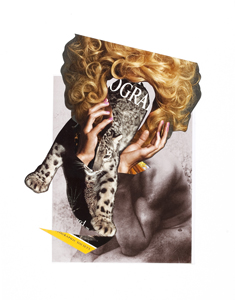
Born in Kano (NG). Lives and works in Princeton (US).

2014
Collage on Paper Arches Hot Pressed Watercolour 300LB.
60.9 x 45.7 cm
Marcia Kure is a Nigerian artist based in the United States. She studied at the University of Nigeria-Nsukka, notably under the painter Obiora Udechukwu. The four collages in her series Ethnographica (I, IV, VI, and VI) may be read as an attempt, made by the artist in multiple media, to give a metaphorical and critical form to human bodies and what they wear. “What they wear” may be what protects them, conceals them, or what they’re clothed in, but also whatever takes part in how they need or wish to present themselves. In Kure’s work, fabrics, watercolors, or collage labor in view of constructing hybrid humanoid bodies, apparently always meant to reveal the meanders of the very concept of — and perhaps even desire for — identity and cultural belonging. Collages are a way of fusing together, as well as of superposing (and hence of setting them one against the other) image fragments extracted from a world where a priori they would have never come in contact, for example hip-hop culture and Victorian fashion. And yet, it is often the case that these worlds do overlap in our globalized societies, subject to multiple influences, where fashion, music, and advertisement lump them together without a second thought. The creatures in Ethnographica are of that order: they are contemporary and they sample — in the sense of sampling as a productive concept for thinking through the 21st century 1 — ethnographic images (coming from imperialist classifications), traditional fabric patterns, photographs of hip-hop musicians, reproductions of ancient sculptures, pages from women’s fashion magazines, and documentary photographs of animals from National Geographic. The final result is nevertheless a body: a body that makes sense, despite its chaotic appearance. Ethnographica challenges the definition and history of ethnography, a methodology employed in social sciences to study the practices and customs of specific populations, which used to focus mainly on so-called “primitive” societies and was first established only to distance itself from them, but which has been forced today to rethink how it considers and selects its objects of study. Like a researcher, Kure assembles composite bodies with sophistication: past and present bodies; sewn and tailored bodies (for example The Three Graces, 2013, where pieces of felt, cut out and stitched together, synthetic wigs, and wooden shields give shape to portraits, or a group portrait, of three illustrious African women); blurred bodies in watercolor (for example The Renate Series, 2013, spectral representations, recognizable by their sartorial attributes as workers to be remembered by history only anonymously); or pasted cutout bodies (removed from their environment and grafted in another). These bodies are a way of discovering how much we want to conform to aesthetic models, but also of understanding the origins of what we carry in our bodies (education, traumas, and memories) and what we wear (clothes, hairdos, or scars). In 2014, in residence at the V&A Museum in London, Kure analyzed the childlike gesture of disguise carried out by adults who find themselves caught between two cultures that may be at odds, between two irreconcilable imperatives, between contradictory aesthetics. In Kure’s work, the body never escapes its history; on the contrary, it incorporates this history which becomes matter, something that is no longer intellectual but can be touched: a keloid scar, a golden chain, a veil or other pieces of cloth.
Eva Barois de Caevel
1 “A sampler, a machine that reprocesses musical products, also implies constant activity. […] This recycling of sounds, images, and forms implies incessant navigation within the meanderings of cultural history, navigation which itself becomes the subject of artistic practice. Isn’t art, as Duchamp once said, ‘a game among all men of all eras?’[…_ When musicians use a sample, they know that their own contribution may in turn be taken as the base material of a new composition. They consider it normal that the sonorous treatment applied to the borrowed loop would in turn generate other interpretations, and so on and so forth. With music derived from sampling, the sample no longer represents anything more than a salient point in shifting cartography. It is caught in a chain, and its meaning depends in part on its position in this chain.” — Nicolas Bourriaud, Postproduction. Culture as Screenplay: How Art Reprograms the World, trans. Jeanine Herman (New York: Lukas & Sternberg, 2005), pp. 18–19.